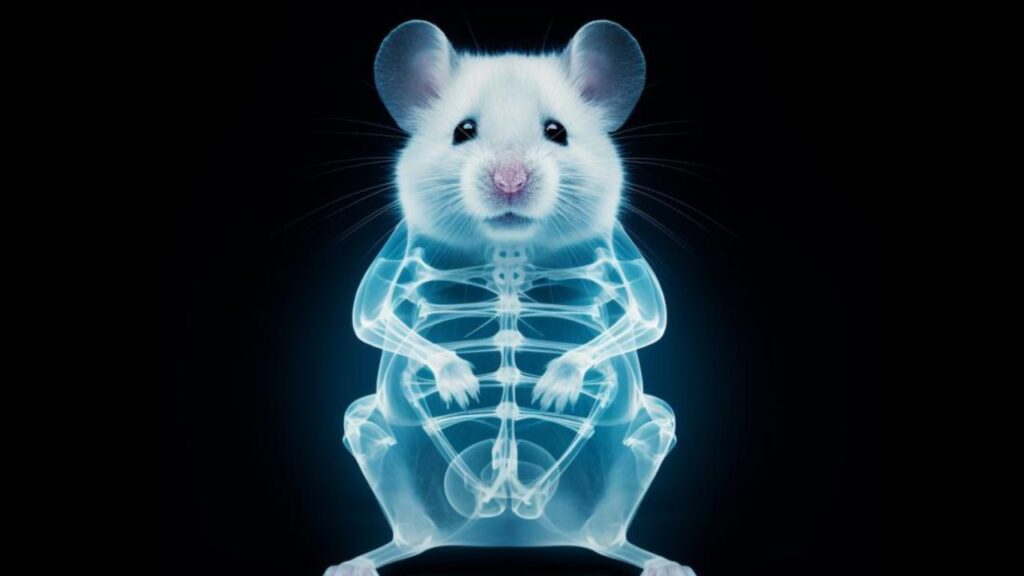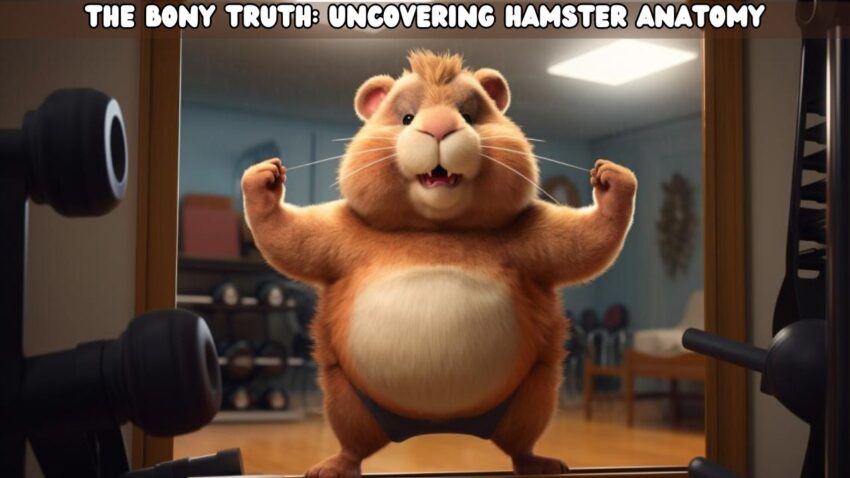TL;DR Summary:
Yes, hamsters do have bones. Their skeletal system, comprising hundreds of bones, is crucial for their physical support, movement, and overall health. This system allows them the flexibility to burrow and squeeze through tight spaces. Understanding the hamster’s anatomy, including their bone structure, is essential for proper care. A balanced diet, safe environment, and regular health checks are key to maintaining their skeletal health. Remember, a happy hamster is a wheel-y happy you!
In the delightful realm of pet ownership, hamsters are often celebrated for their endearing qualities and surprising agility. A frequent topic of fascination is the hamster’s remarkable ability to contort and squeeze through the smallest of spaces, leading some to whimsically question, “Do hamsters have bones?” This query is not just a testament to the hamster’s flexibility but also reveals a common misconception about their physical makeup.
The Hamster’s Skeletal Blueprint
To set the record straight, yes, hamsters do indeed have bones. Like all mammals, hamsters possess a skeletal structure that is both robust and intricately designed to support their body and facilitate movement. Their skeletons provide the framework necessary for muscle attachment, protect vital organs, and, contrary to some beliefs, contribute to their extraordinary flexibility.
Misconceptions About Flexibility
The myth that hamsters might be boneless arises from their ability to navigate tight spaces — a feature that is not due to a lack of bones but rather to a spine that is more flexible than that of many other animals. This elasticity allows them to contract and expand their body as needed, a trait that is crucial for escaping predators and exploring their environment.
The Skeletal System of Hamsters

Peering into the world of these small, nocturnal creatures, we uncover the robust framework that underlies their soft exterior—the hamster’s skeletal system. This complex structure is a marvel of nature, allowing for a range of movements and behaviors that are characteristic of these energetic rodents.
Composition and Function of the Hamster’s Skeleton
The hamster’s skeletal system is composed of several hundred bones, each serving a distinct function vital to the hamster’s survival and daily activities:
- Spinal Column: A hamster’s spine is exceptionally flexible, with more vertebrae than many other mammals, allowing them to contort and fit through tight spaces.
- Skull: The hamster’s skull houses and protects a significant brain for their size, with strong jawbones to support their incisors, which are crucial for gnawing and food processing.
- Limbs: Their limb bones are structured to support swift, scurrying movements, with powerful hind legs for digging and jumping.
The Hamster’s Skeletal Distinctions
Comparing the hamster’s skeletal structure to other mammals reveals several adaptations:
- Size: While smaller overall, the proportion of bone to body size is similar to other mammals, ensuring strength and durability.
- Bone Density: Hamsters have a bone density that is conducive to their burrowing lifestyle, providing the necessary support without compromising on agility.
- Rib Cage: The rib cage of a hamster is designed to protect their internal organs while allowing for the expansion and contraction needed during breathing and movement.
Skeletal Adaptations for Burrowing
Hamsters, particularly those species that burrow, have skeletal adaptations that facilitate this behavior:
- Shoulder Girdle: A well-developed shoulder girdle allows for the robust shoulder muscles needed for digging.
- Pelvic Structure: The pelvis is narrow, aiding in their ability to navigate through tunnels and burrows without hindrance.
Understanding Hamster Flexibility

The captivating agility of hamsters often leaves pet owners in awe as they witness their tiny companions navigate the narrowest of passageways with ease. This flexibility is a defining trait of hamsters, and it is deeply rooted in their bone structure and biological design.
The Architectural Marvel of Hamster Bones
The hamster’s flexibility is afforded by several key anatomical features:
- Vertebral Flexibility: The hamster’s spinal column has a larger number of vertebrae than might be expected for such a small animal, and the intervertebral spaces allow for significant flexibility. This suppleness is especially pronounced in the lumbar region, enabling the hamster to curl and twist their body effortlessly.
- Flexible Ribs: Unlike many mammals, the hamster’s ribs are quite flexible, which helps them compress their bodies to fit through tight spaces without causing injury to their internal organs.
Biological Adaptations for Squeezing Through Tight Spaces
Hamsters are equipped with biological adaptations that support their squeezing capabilities:
- Elastic Skin: The skin of a hamster is loose and elastic, allowing it to stretch as the hamster maneuvers through tunnels or small openings.
- Muscle Composition: The muscles in a hamster’s body, particularly around the spine and hindquarters, are strong yet flexible, providing the necessary force for burrowing and squeezing while still enabling a wide range of motion.
- Compact Organ Placement: The internal organs of a hamster are arranged in such a way that they can be gently displaced when the hamster needs to compress its body, without causing harm or discomfort.
A Survival Trait
This remarkable flexibility is not just for show; it has roots in the hamster’s survival instincts:
- Predator Evasion: In the wild, the ability to quickly escape into small crevices or burrows can mean the difference between life and death when predators are near.
- Environmental Navigation: The hamster’s natural habitat may include narrow passages and underground burrows, which require a body built for squeezing and flexibility to explore and forage for food.
Whisker Tips: Caring for Your Hamster’s Skeletal Health

To ensure our furry friends live a long, active life, it’s vital to maintain the health of their skeletal system. Here are some essential ‘Whisker Tips’ that focus on nurturing a robust framework for your hamster through diet, environment, and exercise.
Nutritional Foundations for Strong Bones
A balanced diet is crucial for skeletal health:
- Calcium-Rich Foods: Incorporate calcium-rich foods into your hamster’s diet to support bone strength. Broccoli, kale, and turnip greens are excellent options, but always introduce new foods gradually to avoid digestive upset.
- Vitamin D: This vitamin is essential for calcium absorption. Ensure your hamster’s diet includes fortified pellets, which typically contain the necessary Vitamin D.
- Balanced Diet: Alongside fresh veggies, provide a variety of seeds, grains, and occasional protein sources like boiled egg or mealworms for a well-rounded diet.
Creating a Bone-Healthy Habitat
The right environment can support skeletal health:
- Chew Toys: Hamsters need to chew to keep their continuously growing teeth healthy. Wooden chew toys or untreated willow branches can encourage this natural behavior.
- Safe Enclosures: Avoid wire floors or rungs that can cause injury. Solid, flat surfaces are best for running and playing.
Exercise Essentials
Regular activity is as important for hamsters as it is for us:
- Exercise Wheel: Ensure your hamster has access to a solid running wheel to encourage daily exercise, which is vital for maintaining strong bones and overall health.
- Playtime: Allow your hamster time outside of their cage in a hamster-safe playpen or supervised area to explore and exercise.
- Burrowing: Provide ample bedding for digging and burrowing, which can help hamsters build strong muscles that support bone health.
Monitoring Bone Health
Keep an eye out for signs of skeletal issues:
- Regular Check-ups: A routine veterinary exam can help catch any potential bone health issues early.
- Watch for Limping: If your hamster shows signs of discomfort while walking, it may indicate a problem requiring veterinary attention.
- Be Alert to Posture Changes: Any changes in the way your hamster stands or moves can be significant.
Common Bone-Related Health Issues in Hamsters

While hamsters are robust little creatures, they are not immune to skeletal health issues. Understanding common bone-related conditions can help hamster owners prevent, recognize, and seek treatment for these problems.
Skeletal Health Issues in Hamsters
Several bone-related health concerns can affect hamsters:
- Metabolic Bone Disease (MBD): This condition is akin to osteoporosis in humans and is often due to a lack of calcium in the diet, leading to weak and brittle bones.
- Fractures: Hamsters are active and can sometimes suffer from broken bones due to falls or improper handling.
- Dental Problems: Overgrown teeth, which are common in rodents due to their continuously growing incisors, can lead to dental and jawbone issues if not properly managed.
Preventive Measures for Bone Health
Preventing these conditions involves several proactive steps:
- Balanced Diet: Ensure your hamster’s diet is rich in calcium and Vitamin D to prevent MBD and support overall bone strength.
- Safe Environment: Design your hamster’s living space to minimize the risk of falls and injuries. Avoid high platforms without barriers and ensure that the wheel is the correct size to prevent back curvature or injury.
- Chew Opportunities: Provide appropriate chew toys to help maintain dental health and prevent overgrowth that could affect their jawbone.
Recognizing Signs of Bone Health Issues
Be vigilant for symptoms that could indicate a problem:
- Limping or Unwillingness to Move: This could signify a fracture or other bone injury.
- Difficulty Eating: This may indicate dental issues, which can affect the bones in the jaw.
- Posture Changes: A hunched posture or reluctance to stand can be a sign of bone pain or weakness.
Conclusion: Embracing the Backbone of Hamster Health

As we conclude our journey through the inner workings of hamster anatomy, it becomes clear that a comprehensive understanding of their skeletal structure is crucial for any caretaker committed to their well-being. The bones of a hamster are not just the hidden scaffolding beneath a layer of fur; they are the pillars that support every aspect of these delightful creatures’ active lives.
The Vital Role of Bones in Hamster Health
The hamster’s skeletal system is a marvel of biological engineering, facilitating everything from their characteristic burrowing to the endearing way they clutch treats with their tiny paws. Bones provide the necessary framework for movement, protect vital organs, and play a critical role in overall health. The delicate interplay between diet, environment, and genetics shapes the health of this crucial system.
The Big Picture of Hamster Care
Understanding the full picture of hamster anatomy, particularly their bones, empowers us as pet owners to create a living space that caters to their needs:
- Diet: A balanced diet rich in calcium and Vitamin D is the foundation of strong bones.
- Environment: A safe and stimulating environment encourages natural behaviors while minimizing the risk of injury.
- Observation: Regular, attentive observation helps us to spot any signs of distress or disease early, allowing for prompt veterinary care.
Final Thoughts on Hamster Anatomy
As we integrate this knowledge into our daily care routines, we enrich not only the lives of our hamsters but also our own experiences as caretakers. We become more attuned to the subtleties of their behavior, more responsive to their needs, and more invested in their health and happiness.
In caring for a hamster, we are gifted with a window into the fascinating world of a creature perfectly adapted to its ecological niche, with every bone and behavior a testament to its evolutionary heritage. As custodians of their well-being, let us commit to providing the best care possible. And with every step we take to ensure our hamster’s health, we are rewarded with the joy of their companionship. Remember, a happy hamster is a wheel-y happy you!




